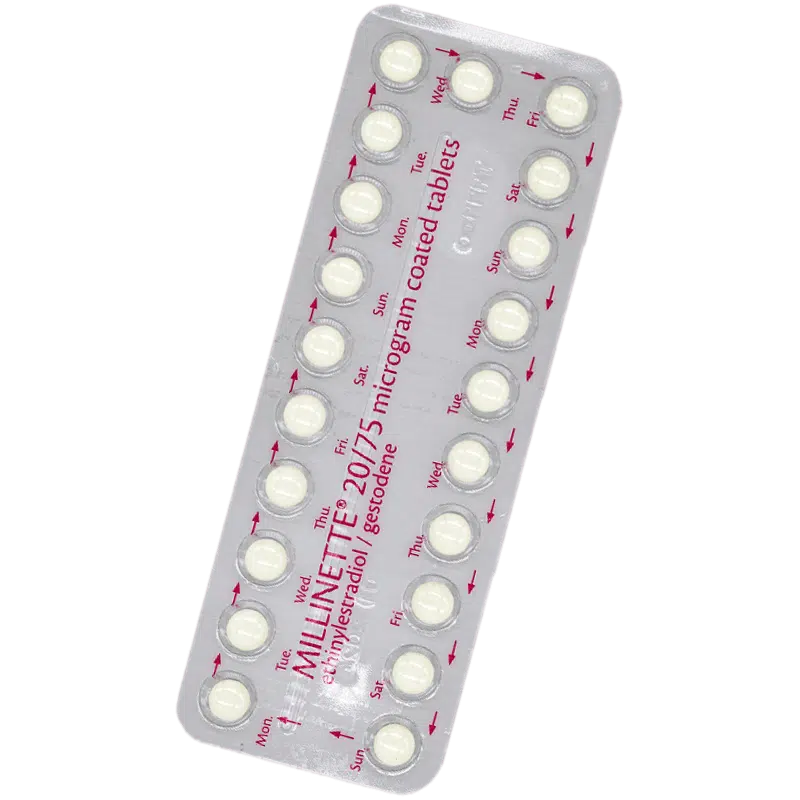A combined pill with low and high dose options.


Millinette is a combined hormonal contraceptive pill that gives you some flexibility. It’s available in two different doses, so if you’re a little more sensitive to oestrogen, it’s a pill that can give you fewer side effects.
Start a conversation with us to get personalised advice on birth control. Order Millinette online to get your pill delivered when you need it.
Millinette is a combined contraceptive pill that contains a low dose of oestrogen (it’s sometimes referred to as a ‘low-dose’ combined pill). Some women are more sensitive to oestrogen than others, and are more prone to side effects from it. If this applies to you, Millinette may be a particularly suitable choice.
It’s a 21-day pill, so you take it for 21 days, and then have a seven-day ‘pill-free’ break. But you can also use it continuously (one pill every day, with no pill-free break) or more extensively (one pill daily for nine weeks, and then no pills for the following four or seven days).
Like other combined pills, Millinette protects you from getting pregnant in three ways.
The two hormones in Millinette prevent ovulation from taking place (when an egg is released from your ovary) to reduce your chances of becoming pregnant.
The pill also helps the mucus in the cervix get thicker, which makes it more difficult for sperm to reach an egg.
The lining of the uterus is made thinner too. This lining builds up over the course of your cycle, and then breaks down when you have your period. Because the pill makes the uterine lining thinner, it’s harder for a fertilised egg to embed itself there and grow. It usually means that your period is also lighter, and less painful.
If you take it as instructed, it’s over 99% effective. So if 100 women take it perfectly over 12 months, just one will get pregnant.
But if you make mistakes when you use it, or if you miss a pill here and there, it’s slightly less effective. You can help to avoid this by taking it at the same time every day, as advised in the information leaflet that comes with your treatment.

How we source info.
When we present you with stats, data, opinion or a consensus, we’ll tell you where this came from. And we’ll only present data as clinically reliable if it’s come from a reputable source, such as a state or government-funded health body, a peer-reviewed medical journal, or a recognised analytics or data body. Read more in our editorial policy.
If you start to take Millinette on the first day of your period, you’ll get immediate protection from pregnancy. You can also start to take Millinette on days two to five of your period, but if you do this, you should use additional contraception for the first seven days while the pill takes effect in the body.
Take the pill at the same time each day, in the order displayed on the strip, until you have finished all 21 pills.
Once you have finished the strip, take a seven-day pill-free break. It’s likely that you’ll experience a bleed during this time. So long as you’ve taken the pill correctly and not missed any pills, you don’t need to use any other form of contraception over the seven-day break.
After the seven pill-free days have passed, start a new strip. You may still get some bleeding at this point, but you should start a new strip regardless. If you take the pill as instructed, you should always start a new strip on the same day of the week.
You should read the instructions in the information leaflet that comes with your treatment before starting to take Millinette.
Yes. You can also take Millinette on a continuous basis (1 pill every day, with no pill-free break) or on an extended basis (1 pill every day for 9 weeks, and then no pills for the next 4 or 7 days). If you’d prefer to take Millinette in either of these ways, our prescriber can talk you through each option during your consultation.
If less than 12 hours have passed since you missed a pill, you should take it as soon as you remember. Take any pills that follow at the usual time. This will not affect the protection from pregnancy that Millinette offers you.
Should you find that more than 12 hours have passed since you forgot to take a pill, or if you forgot to take more than one pill, your protection from pregnancy may be reduced. As soon as you remember, take the pill you missed most recently, even if this means taking two pills on the same day.
You should then take any pills that follow at the same time, and use an extra form of contraception, such as condoms, for the next seven days. If you take the last pill from the strip during this seven-day period, start taking pills from a new strip as soon as the current strip is finished, without taking a seven-day, pill-free break.
It’s unlikely that you’ll get a withdrawal bleed while taking pills from the second strip, but you can get some blood spots or breakthrough bleeding. If you don’t get a withdrawal bleed after you finish the second strip, let our clinician know, as you may be pregnant. They can advise you on what to do next.

How we source info.
When we present you with stats, data, opinion or a consensus, we’ll tell you where this came from. And we’ll only present data as clinically reliable if it’s come from a reputable source, such as a state or government-funded health body, a peer-reviewed medical journal, or a recognised analytics or data body. Read more in our editorial policy.
Have something specific you want to know? Search our info below, or ask our experts a question if you can’t find what you’re looking for.
Weight and Body Composition Changes During Oral Contraceptive Use in Obese and Normal Weight Women. Journal of Women’s Health, 23(1), pp.38–43.
It helps me a lot.
It helps me a lot. My monthly period is become regular
Very good!
Very good!
Treated
Good, efficient service
Excellent service
Excellent service
So satisfied!
So satisfied!
Great experience
I ordered my medication as I didn’t think mine would arrive in time and was so easy to do so. Would recommend this to everyone. Easy to use!
Professional
Great service. Love the renewals that automatically arrive without my thinking.
Thank you. It's that tablets
Thank you. It's that tablets which I needed.
They gave it me when everywhere else was out of stock lol
They helped me thank u
Thanks
Thanks
Efficient.
Efficient service, great delivery, seems well organised, thank-you.
Excellent
Easy speedy service would highly recommend
For now it is okay
For now it is okay I don't feel nausea when I take them
Seamless Service and Reliable Contraceptive Solution
My experience with Treated has been nothing short of exceptional. Transitioning from the US to the UK, I needed to replenish my contraceptive pill supply, and Treated made the process incredibly smooth and hassle-free. The online consultation with a doctor was convenient and reassuring. I was able to explain my requirements, and the doctor provided me with several suitable alternatives, ultimately leading me to Eloine, which has been a perfect fit for me so far. The guidance and support I received throughout the process were invaluable, and it was evident that the doctor had my best interests at heart. What truly impressed me was the speed of the entire process. Once I made my decision and completed the necessary steps, my order was promptly dispatched and arrived at my doorstep the very next day. Such efficiency is a rarity these days, and I commend Treated for their commitment to customer satisfaction. As for the product itself, I have been using Eloine for just over a week now, and I am pleased to report that everything is going well. It's comforting to know that I have access to a reliable contraceptive option that meets my needs, all thanks to Treated. I am grateful for the peace of mind they have provided me, and I will certainly be returning for any future healthcare needs. Thank you, Treated, for exceeding my expectations.
Brilliant
Brilliant service, knowledgeable staff. Medication is working. Thank you
I have been using Yasmin
I have been using Yasmin and it has improved my cycle to be better.
Great service
Really fast and efficient service and great communication with the team.
Great service
Would recommend
Pro, helpful and reactive!
Thank you. You guys have been very reactive in sending me my new order in emergency, as you had IT issues and the automatic renewal of pills is still not working (parcel not cleared up from previous order).
Perfect
No worries of having to re order. All done and sent in good time. Thank you as always.
Very good
Very good
Good use
Fine tablets. Do the job.
Perfect
Perfect
Amazing!
Always so helpful whenever I have any questions
Great service
I recently needed to make a change and the website was not allowing this. The team at Treated, picked it up and were able to resolve successfully for me, quickly. Thank you.
Everything good
Everything good
Excellent service
Quick and easy service to use. When I had a query they answered promptly and were helpful. Thanks

Registered with GMC (No. 4624794)
Meet Daniel
Registered with GPhC (No. 2202465)
Meet Sanjeda
Registered with GPhC (No. 2070724)
Meet CraigDelivery, consultation, treatment. It’s all included in the price.
| Quantity | Starting from |
|---|---|
| 63 Tablets | £29.95 |
| 126 Tablets | £48.95 Save £10.95 |
| 252 Tablets | £78.95 Save £40.85 |
| Quantity | Starting from |
|---|---|
| 63 Tablets | £32.95 |
| 126 Tablets | £52.95 Save £12.95 |
| 252 Tablets | £84.95 Save £46.85 |
| Quantity | Starting from |
|---|---|
| 63 Tablets | £34.95 |
| 126 Tablets | £55.95 Save £13.95 |
| 252 Tablets | £89.95 Save £49.85 |
| Quantity | Starting from |
|---|---|
| 84 Tablets | £34.95 |
| 168 Tablets | £55.95 Save £13.95 |
| 336 Tablets | £89.95 Save £49.85 |
| Quantity | Starting from |
|---|---|
| 63 Tablets | £29.95 |
| 126 Tablets | £44.95 Save £14.95 |
| 252 Tablets | £75.95 Save £43.85 |
| Quantity | Starting from |
|---|---|
| 63 Tablets | £32.95 |
| 126 Tablets | £49.95 Save £15.95 |
| 252 Tablets | £84.95 Save £46.85 |
| Quantity | Starting from |
|---|---|
| 63 Tablets | £32.95 |
| 126 Tablets | £47.95 Save £17.95 |
| 252 Tablets | £78.95 Save £52.85 |
| Quantity | Starting from |
|---|---|
| 63 Tablets | £26.95 |
| 126 Tablets | £41.95 Save £11.95 |
| 252 Tablets | £72.95 Save £34.85 |
| Quantity | Starting from |
|---|---|
| 63 Tablets | £39.95 |
| 126 Tablets | £63.95 Save £15.95 |
| 252 Tablets | £109.95 Save £49.85 |
| Quantity | Starting from |
|---|---|
| 63 Tablets | £34.95 |
| 126 Tablets | £57.95 Save £11.95 |
| 252 Tablets | £91.95 Save £47.85 |
| Quantity | Starting from |
|---|---|
| 63 Tablets | £27.95 |
| 126 Tablets | £43.95 Save £11.95 |
| 252 Tablets | £78.95 Save £32.85 |
| Quantity | Starting from |
|---|---|
| 84 Tablets | £27.95 |
| 168 Tablets | £43.95 Save £11.95 |
| 336 Tablets | £78.95 Save £32.85 |
| Quantity | Starting from |
|---|---|
| 63 Tablets | £25.95 |
| 126 Tablets | £41.95 Save £9.95 |
| 252 Tablets | £66.95 Save £36.85 |
| Quantity | Starting from |
|---|---|
| 63 Tablets | £41.95 |
| 126 Tablets | £61.95 Save £21.95 |
| 252 Tablets | £98.95 Save £68.85 |
We know health, but you know you.
Our experts tell you what’s safe, but you decide what’s best.
Answer a few questions and tell us about yourself. Get tailored advice from our clinicians so you can choose better.

Choose your treatment and how often you have it delivered.

We know things change. It’s the nature of life. We’ll check in regularly to make sure your treatment is still right for you.
Pause. Change. Skip. Start again. Any time you like.
Always arrives on time and I’m kept informed of progress.
I have had it previously from my G.P so It worked as expected, extremely well. My problem is an accessing my G.P practice, they put ED well down their list of priorities. I found your service excellent, quick and efficient. I fully intend to continue using it
Shipping is speedy and the product is amazing.
Fast, slick service. Very easy to amend subscription when required.
All good.
Great service
Really helped me
Trusted service and great service - next day delivery and I can rely on them to send regularly.
Ordering was straight forward, tablets delivered promptly and well packaged, and instructions were clear, thanks.
100% recomended.Great service
Excellent service
Excellent delivery. Can’t fault.
Quick and efficient service, delivered discreetly the next day. Thank you.
Effective
Great service, no wait time
Great
Quick assessing for medicine suitability. Quick delivery and good communication throughout.
Straightforward and quick service!
Good however communication could sometimes be better
Easy and good procedure to get treatment
Excellent product
Excellent service!!! Ordered what I needed sent a picture of my prescription and the parcel arrived the next day!!! Will definitely order again and have recommended to others!!!
Fast shipping
Very quick service all round
So quick and simple. Recommend
Great
Very convenient hassle free service.
Easy to use good communication and fast shipping
Great service
Efficient no issues re delivery
Fabulous service
Brilliant service. Not a bad word to say!
It was fast, professional and it's the right med for what I selected in there.
This review requires content. Oh well..
Great service, quite effortless.
Top notch
Brill service
N/a
Excellent service quick and easy to use
Fast and exact order
Superb service and quick delivery 10/10
Excellent service
Thank you for fast delivery
Shipping is extremely quick and satisfiying
Good stuff
Good service
Great fast delivery
Combined pills: Here are some other options.
Standard oestrogen dose. Similar to Millinette and Katya. 21 and 28 pill options available.
Comes as a 'standard' oestrogen dose or a lower dose option. Very similar to Marvelon and Mercilon.
Standard oestrogen dose pill that's very similar to Femodene and Millinette.
Safest category pill, helps with heavy menstrual bleeding. Very similar to Rigevidon and Microgynon.
Very similar to Yasmin. Can help with PMS and making your periods more regular.
Pill with a 'regular' oestrogen dose. Comes in a 21 pack. Very similar to Cimizt and Gedarel 30.
Safest category pill that reduces heavy bleeding. Same hormone mix as Levest and Rigevidon.
Very similar to Microgynon and Levest. Safest category pill that helps with heavy menstrual bleeds.
Well known pill that reduces PMS symptoms and can help to make your periods more regular.
We're making healthcare more about you. Sign up to our newsletter for personalised health articles that make a difference.
Disclaimer: The information provided on this page is not a substitute for professional medical advice, diagnosis, or treatment. If you have any questions or concerns about your health, please talk to a doctor.
We couldn't find what you're looking for.
Here's everything we treat. Or, if you're looking for something we don't have yet, you can suggest something.
If there’s a particular treatment or condition you’re looking for, tell us and we’ll look into it for you.
Submit your question here, or tell us if you’ve found an issue on our site.
We’ll get back to you very soon. We aim to respond to all queries in one working day.
You’re signed up to our newsletter. Keep an eye on your inbox for our latest update.
By clicking 'Subscribe now' you're agreeing to our Privacy Policy.
We’ve sent you an email asking you to confirm your email address.